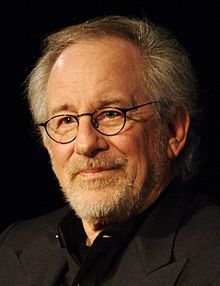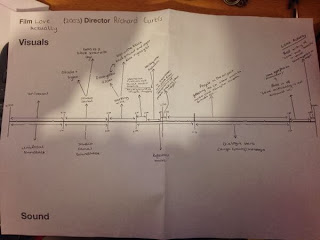Cinematic/Real Time
Time that a given sequence takes to play on the screen as opposed to 'real time'. In film time can be compressed or expressed.
When Match -On-Action happens, Cinematic time is the same as real time.
Shrinking Time
Through a series of fast paced cuts we can see things that would take a long time in a few minutes or seconds. Instead of watching a character get in a car and drive for 20 minutes we see them get in and then get out, letting us assume that the journey has taken place.
This can also confuse the audience if the film has constantly shrunk time and we have no ability to process what's happened.
Expanding Time
The editor can expand time by adding additional detail. For example, someone is sitting I a chair waiting for the phone to ring. In real time this might only last half a minute. But the editor can build up tension by including shots of the person's eyes, taping fingers (to show impatience) etc..., drawing the scene out to a minute or more. We are looking at 'film' time, not real time
Finding Rhythm
Editing sets the rhythm or pace of scene. This could be dictated by either the music used behind a scene or the mood that the editor is trying to create and the pace that you edit. To build up tension in a scene you might cut from one shot to another very quickly. However, in a relaxed scene the editing will progress at a much slower pace, dwelling longer on each shot.
For example, watch between from 17:16 - 19:45
Cinematic : When watching this film, you have one part where
between 18:54 - 19:24. The comparison between filming it and real life is the
same. The Millionaire setting only took 30 seconds and it would only occur for
30 seconds in real life. This has an impact on the audience as you get to relax
a bit and take in what you have previously watched to understand what is happening. As if you were taking a bit of a break from the tension of the film.
Expanding : Between 16:09 - 16:25, time expands to tell the context of the story. So you know that it is a developing country and it may be India because at those days and still now people used to clean their clothes in the same place they bathed in and played it so it was very unhygienic. Not only is the context created but the character characteristics are presented. We see the little boy and a women who we can only presume is his mother so we know something about the people in the shot.
There isn't any spacial area which hints the lack of hygiene.
The use of the pool playing maybe creates a happy connotation compared to the surroundings
They are cleaning the clothes in the same place where the children are playing.
We see a female character looking at another person.
The other person in a child which is playing to his hearts' content.
Shrinking: We saw it between 16:25 - 16:40. We can see the mother's reaction shot of the train as if it is foreshadowing something. This quick shot of the mother and the train shrinks time and gives this tension building curiosity that makes our hearts start to race.
Looking away as she may hear something strange
Normal 'Indian' packed train that passes by with people walking beside.
Curious about behind what's in the train. (Between the first OSS shot to the mid-shot, timing wise it has been about 1-2 seconds)
The mother might of understood what's happening and that has reacted to it which again looking at someone.
The coincidence of her heart beating fast and looking at her child may suggest he will be apart from her or she will part away from him in some way.
She looks again at the train that's passing by.
Then the fear comes to life after the train passes by and a lot of angry men come out screaming.































